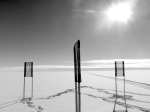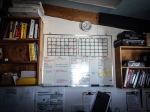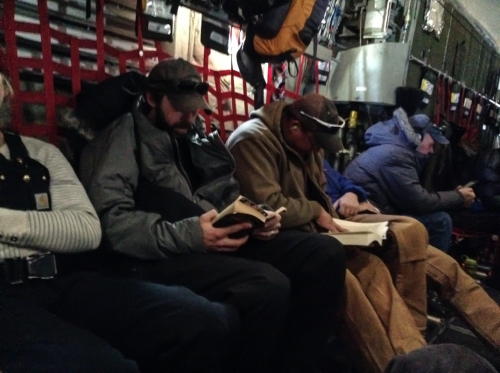“Down South” (meaning the USAP and Antarctica) flights happen almost daily through the summer season to field camps and Pole. It’s at a bigger scale, more planes involved, more crews. Up here in Greenland we have Flight Periods during which a few hercs at a time fly up to Greenland and complete missions to Summit. This means that we have a week or so of intense flight activity, one or two flights a day, and then a break of 2-3 weeks without any flights at all.
The arrival of an LC-130 Ski equipped Herc is a significant event at Summit. Most of the fuel on station is brought in via plane, so the morning of a flight requires that the mechanic reconfigures our fuel system to receive fuel. The cargo coordinator is busy prepping and staging cargo. The HEO is involved if we plan to use the cargo sled. The field coordinator is busy gathering loose load, helping with the fuel pit reconfiguration and with last minute cargo issues. As the manager, my role is to provide hourly weather observations, aka wx obs, 3 hours prior to the offdeck (the first ob is usually due at 450am). These are sent to a wide group of folks in the US and around Greenland via email and will determine whether the conditions meet the requirements for the flight. The manager also coordinates with the Air National Guard unit based in Kangerlussuaq regarding manifest or schedule changes and relays this to the team at Summit.
When a plane is in the air we monitor designated HF and VHF channels in the Big House. Once the plane is approximately 30 minutes out we are able to make contact with our air to ground radio and confirm current weather conditions, estimated fuel amounts, and cargo details.
The herc lines up with the skiway and comes in to land, much like on a tarmac runway except there are large skis that sit below the wheels. These can be raised or lowered so they can take off on the tarmac of Kanger and land on our snow skiway. The skiway at Summit is one of the longest in the world – 3 miles long and lined with rows of black flags. Approach flags extend 2 miles off both ends of the skiway. Near the station are the fuel pits and a groomed area marked off by lesser flags, this is the taxiway where the planes park for fuel and cargo operations.
Once the plane has landed and pulls off onto the taxiway, the skis are raised to prevent them from freezing to the snow surface. While the plane is on the ground at a cold remote site such as Summit, field camps, and the South Pole – the propellers are left running to circulate fluid and to avoid potential problems from shutting down and restarting the engines. It makes for a very loud and potentially dangerous environment. The propwash is incredibly strong and the exhaust at any point behind the tips of the wings is overpowering so those working behind the plane in the exhaust plume wear fitted respirator masks. When it gets really cold (below -50F or so) contrails form on the ground limiting visibility and restricting cargo operations.
On the ground the loadmaster steps off herding the pax if any, away from the props and around the front of the plane. The flight engineer follows and walks around the wingtip to the fueling port while the rear doors of the plane open and cargo offload begins. Our mechanic hauls out the heavy duty fuel hose just under the wing and works with the flight engineer to pump fuel into our bladders and tanks. This flight period we’ve been averaging about 3000 gallons of fuel per flight. Meanwhile cargo is unloaded and loaded onto the plane with loaders or sleds. The Hercs can fit 6 pallets with no pax.
In the office I relay information over two different radios between the flight crew in the plane and the folks on the ground and back to Kanger as necessary. Often the pilots will want updated wind speeds and altimeter readings or forecasts from Kanger.
“Summit Station, Skier 71”
“Skier 71, Summit, Go ahead”
“Summit, what is your current wind and altimeter please?”
“Skier 71, wind is one eight zero at zero seven knots, altimeter is three
zero zero seven”
“Copy all and can you relay to Sonde our ETD Summit is 1330 zulu?”
“Affirmative”
I log all operations, communications, fuel numbers, and pallets loaded with their weights and dimensions, watching as I can from the Big House office. The planes are often on the ground for an hour to an hour and a half, though it’s a fast hour.
Once they depart there’s a weight off of everyone’s shoulders. Folks get busy cleaning up – reconfiguring our fuel system to transfer fuel between tanks and bladders, checking in and delivering cargo, grooming the skiway as needed, delivering baggage, and orienting passengers new to Summit.
With cargo and fuel operations completed any departing pax are ushered onto the plane and they prepare to depart. On skiways, especially here at Summit, being at 10,550ft and with summer temperatures as warm as 25F, taking off can be a bit of a challenge. Soft sticky snow, thin air, heavy loads…all of these can result in a futile “slide.” The plan taxis back onto the runway and gives it a good go – engines gunned, props spinning, snow flying up behind the skis…they rush down the runway with all eyes on station watching for the moment they offdeck. Often they just can’t get enough speed and at the end of the skiway they feather the props, slow, and turn around for another go. They gun it again, the sound washing over the station…props spinning, snow flying up in a cloud behind the plane, binoculars are out and folks are pressed against windows and on the decks, holding their breath. This time the front ski lifts…a little more…and the back skies are off the snow – we have an offdeck! Someone shouts over the radio “the skier is offdeck!” and I log it in my records and send out a notice to the wider group that the skier is headed off.
We’ve had good luck this flight period – almost no slides. The most I’ve seen here at Summit is 11 tries…at that point they had unloaded most of the cargo and even taken on some of the fuel they just delivered. The fewer slides the better. The earlier in the day the colder…the better.
Flight days are long and sometimes stressful, but they’re exciting too and it’s always good to see retro cargo leave and to receive mail and freshies! Today’s flight was the last of this flight period. We sent off 19 pax leaving just 11 of us here on station.

















